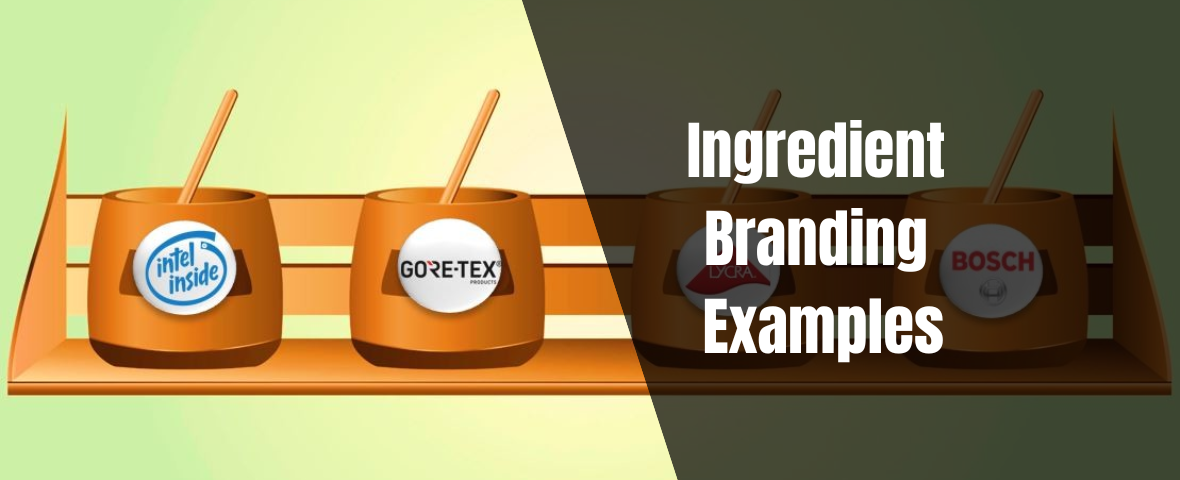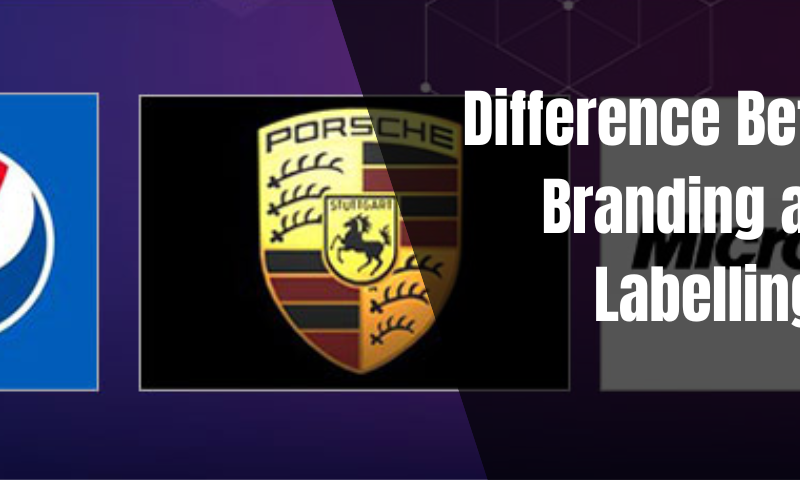
Ingredient Branding Examples
Ingredient branding refers to a marketing strategy that encompasses promoting a specific component or ingredient within a product as a distinct and recognizable brand. In this type, companies focus on highlighting the unique qualities, benefits, or origins of a particular ingredient or component, instead of marketing the overall product.
This strategy is used to create a perception of quality, trust, and differentiation that ultimately influences consumer preferences by associating the ingredient with positive attributes.
Why Do Companies Use Ingredient Branding?
Companies use ingredient branding to draw attention to the value and significance of a key component, which can have a substantial impact on the consumer’s purchasing decision.
When these ingredients are effectively branded, it can leverage the reputation and recognition of the individual component to build brand equity and enhance their overall market positioning.
Why Ingredient Branding is Important
There are several reasons why ingredient branding is important. To begin with, it allows companies to distinguish their products in a highly competitive market space. Highlighting a specific ingredient or component with its own brand identity can help businesses set themselves apart from competitors and create a unique selling proposition.
This distinction helps attract consumer attention and can influence purchasing decisions, especially when the ingredient is associated with desirable qualities such as quality, innovation, or reliability.
Moreover, consumer trust and confidence are improved through ingredient branding. It is indeed a fact that when a popular ingredient or component is branded and promoted separately, it acts as a symbol of quality and authenticity.
Consumers often associate familiar ingredient brands with superior performance, safety, or effectiveness, which can reduce perceived risk and increase their willingness to choose a product featuring that ingredient.
By using the reputation of an ingredient, companies can strengthen their brand and gain a competitive edge in the market, ultimately driving sales and brand loyalty.
Benefits of Ingredient Branding
While discussing the importance of ingredient branding, one needs also to understand what key benefits this marketing type brings to businesses. Let’s have a look at a few of those benefits:
Differentiation: Ingredient branding allows products to be exclusive in crowded markets by highlighting the unique qualities and benefits of a specific component. This can attract consumer attention and distinguish them from competitors.
Quality perception: Perception plays an important role in marketing. Ingredient branding often carries a perception of quality and reliability for consumers. When they recognize a trusted ingredient brand, it can instil confidence in the overall product’s performance.
Competitive advantage: Using a well-known ingredient or component provides a separate competitive advantage, especially if that ingredient is highly regarded for its attributes.
Trust and credibility: Ingredient branding can foster trust and credibility among consumers. This is largely because they can associate familiar ingredient brands with superior quality and authenticity.
Consumer loyalty: Through ingredient branding, consumers may develop loyalty over time. The loyalty is not only to the product but also to the branded component, thus leading to repeat purchases and brand preference.
Effective marketing: Companies can team up with ingredient suppliers to co-promote their products. This will create mutually beneficial marketing campaigns that can reduce marketing costs and expand the reach of their branding efforts.
Increased visibility: Ingredient branding increases the visibility of the product and can make it more memorable to consumers. This factor is crucial in a market where numerous choices exist.
Consumer education: It provides a chance to educate consumers about the value and importance of specific components within the product, thereby developing a deeper understanding of its features and benefits.
Perceived value: Ingredient branding increases the perceived value of the product. This potentially justifies higher price points and generates increased revenue.
Long-Term branding: By building a strong brand for the ingredient, companies can lead to long-term recognition and success in the market. This in return will benefit both the ingredient supplier and the end-product manufacturer.
Ingredient Branding Strategies
There are several ways to employ ingredient branding effectively. The aim is to achieve results and success through some fundamental strategy that should be kept in mind. Let’s look at a few of those strategies:
Selecting the right ingredient: As the name suggests, the ingredient is the main focus. Hence, choosing an ingredient or component that adds value to the product is mandatory. This component should possess unique qualities or benefits that can be highlighted and can be made a key selling point.
Creating a distinct brand identity: It is important to develop a separate brand identity for the ingredients. This includes factors like a logo, tagline, and messaging that can highlight its strengths and characteristics.
Promotes the ingredient’s benefits: Consumers should be communicated about the advantages of the ingredient. The focus should be on how it enhances the overall product, whether it’s quality, performance, sustainability, or other factors.
Collaborating with ingredient suppliers: Another great strategy for success in ingredient branding is collaborating with the suppliers of the branded ingredients. This is done to ensure alignment in marketing efforts and to create co-promotional campaigns that maximize the impact of ingredient branding.
Consistency: Marketers seeking to get success in ingredient marketing must be consistent. By maintaining consistent branding for the ingredient across all product packaging, marketing materials, and advertising a recognizable brand image can be developed.
Educate Consumers: Implementing educational marketing strategies can be of great help. This strategy can inform consumers about the role and importance of the branded ingredient in the product thus guiding them to make an informed decision.
Use digital platforms: In the presence of digitalisation, all companies are taking extra care to incorporate digital and social media strategies in their marketing efforts. Similarly, in ingredient branding, marketers must utilize digital platforms and social media to reach a wider audience and engage with consumers who are increasingly seeking information online.
Transparency: It is a well-known fact that transparency builds trust like no other. When brands are transparent about the source and quality of the branded ingredient, it can build trust with consumers. This is especially important in industries where ingredient sourcing and quality are critical.
Track and Measure: Keeping track and measuring performance can help companies to remain in the game. Hence, by implementing metrics to track the effectiveness of ingredient brandings, such as consumer surveys, sales data, and brand recognition studies, marketers can refine their strategy for better results.
Compliance and Regulations: Ensuring that all practices of ingredient branding must comply with relevant regulations and standards in the industry is a must. This is to avoid any legal issues that may arise if any of those regulations are not adhered to.
Therefore, by following these strategies, companies can effectively use ingredient branding to differentiate their products, build consumer trust, and improve brand recognition.
7 Ingredient Branding Examples
To understand how ingredient branding strategy works, it is wise to look at a few Ingredient Branding Examples that have done it right. These companies and their strategy have successfully gained the needed results. Let’s have a look at a few detailed examples of ingredient branding for each of the mentioned brands below:
1. Intel Inside
Component: Microprocessors for computers.
Strategy: Intel is known to revolutionize the computer industry. They have done it by implementing one of the most iconic ingredient branding campaigns. The “Intel Inside” logo is prominently displayed on computers and laptops, indicating that the product contains an Intel microprocessor.
Intel’s branding emphasizes performance, speed, and reliability which should be taken into account for marketers who want to venture into ingredient branding. Needless to say, the campaign has been highly successful to the point where consumers look for the “Intel Inside” logo as a mark of quality when purchasing computers. It significantly contributed to Intel’s supremacy in the microprocessor market.
2. Gore-Tex
Component: A high-performance material for waterproof and breathable outerwear, footwear, and various industrial applications.
Strategy: Known for its innovative material technology, Gore-Tex’s branding aims to emphasize its exceptional waterproof and breathable qualities. This makes it a sought-after component in outdoor wear. The promise saying “Guaranteed to Keep You Dry” is a key part of their branding. Due to this, Gore-Tex has become synonymous with high-quality, weather-resistant outdoor gear. Consumers look for the Gore-Tex label when purchasing items like jackets, gloves, and footwear, trusting its effectiveness.
3. Dolby
Component: Audio technologies for enhancing sound quality in various entertainment systems.
Strategy: Dolby Laboratories is known for its audio enhancement technologies used in cinemas, home theatres, and audio systems. The company’s branding focuses on its immersive, high-fidelity sound experiences. The iconic double-D logo is widely recognized. Consumers, therefore, automatically associate Dolby with superior audio quality which leads to a preference for products featuring Dolby technologies, such as Dolby Atmos or Dolby Vision, for an enhanced entertainment experience.
4. Teflon
Component: Non-stick coating for cookware and various industrial applications.
Strategy: Teflon is a product of Chemours. It is synonymous with non-stick cookware and the branding aims to showcase the easy cooking and cleaning factor. This point makes it a desirable component in kitchenware. The Teflon brand is often prominently displayed on non-stick pans and pots. It has been observed that consumers actively seek out Teflon-coated cookware due to its reputation for non-stick properties, reducing the need for excess oil and ensuring easy food release.
5. Tetra Pak
Component: Packaging technology for liquid food and beverages.
Strategy: Tetra Pak is known to provide innovative packaging solutions for liquids like milk, juices, and other beverages. Their branding focuses on sustainability, efficiency, and product protection. The Tetra Pak logo is a hallmark of their packaging known well to the consumers. Tetra Pak’s branding has made it a preferred choice for companies seeking sustainable and efficient packaging solutions. Consumers also recognize the brand as a symbol of quality in liquid food products.
6. PayPal
Component: Online payment processing platform.
Strategy: PayPal has secure and convenient online payment processing services that are used and trusted by many. The company’s branding highlights easy usage, security, and trustworthiness. The PayPal logo is widely recognized in online retail and e-commerce. Consumers trust PayPal for its secure payment platform, making it a preferred choice for online transactions across various industries.
7. Android
Component: Mobile operating system for smartphones and tablets.
Strategy: Developed by Google, Android is one of the most widely used mobile operating systems. The branding accentuates positive qualities like flexibility, customization, and a vast app ecosystem. The Android logo is an iconic symbol in the mobile industry. Android’s ingredient branding as a result has helped it to become the dominant mobile operating system globally. Manufacturers often highlight the use of Android in their devices to attract consumers looking for a versatile and app-rich mobile experience.
Thus, the above examples demonstrate how ingredient branding can effectively create consumer trust and preference for specific components, leading to their widespread adoption in various industries.
Vital Factor in Ingredient Branding
Now it is time to discuss another extremely vital factor in ingredient branding. Often, when choosing an ingredient brand for a product, many factors come into the picture. Thus, all these factors should be carefully measured to ensure that the branding strategy aligns with the overall business objectives and resonates with the target audience. Here are key factors to take into account:
Relevance: Marketers must ensure that the ingredient or component that they intend to brand should be relevant. It should also be essential to the functionality or quality of the product and should definitely add tangible value to the end product.
Uniqueness and quality: Everyone likes unique or exclusive items. Hence, the particular branded ingredient should possess unique qualities or features that set it apart from alternatives in the market. These distinctive attributes should be emphasized in the branding efforts. Additionally, the ingredients should consistently meet high-quality standards to survive in the market. Therefore, consistency in the quality and performance of the ingredients is crucial for building trust with consumers.
Consumer Benefits: As mentioned before, the benefits that the ingredient provides to the end user must be clearly defined and communicated to the consumer. Whether it’s performance improvements, health benefits, or sustainability, these benefits should be a central focus in the branding.
Consumer Preferences: Thorough research and understanding of the target audience’s preferences and priorities should be non-negotiable. This can help in choosing an ingredient that resonates with the audience’s values and needs eventually increasing sales.
Brand reputation: Marketers can consider the reputation and recognition of the ingredient itself. This is because a well-established ingredient brand can provide a head start in building trust with consumers.
Supply chain reliability: By assessing the reliability of the ingredient’s supply chain, marketers can be ahead of any obstacle. Disruptions or shortages in the supply chain can negatively impact the product’s availability and reputation, hence constant assessment of the supply chain is a must.
Long-Term Strategy: Considering whether the ingredient brand aligns with the long-term business strategy or not can be another factor to decide on. A successful ingredient brand can provide a lasting competitive advantage and support brand recognition over time.
Costs: Weighing the costs associated with ingredient branding, including licensing fees, marketing, and any additional quality control measures that may be necessary is mandatory. Hence, ensuring that these costs are manageable and aligned with the budget is advised.
Market Trends and Competition: Staying informed about industry trends and shifts in consumer preferences can help marketers remain ahead of others. Ingredient branding should adapt to changes in the market to remain relevant and competitive. Also, assessing how the ingredient branding may differentiate the product from competitors and identifying opportunities to use ingredient branding as a strategic advantage can also be greatly helpful.
By carefully considering these factors, marketers can make an informed decision when selecting an ingredient brand that will effectively enhance the product’s appeal, trustworthiness, and overall market position.
Ingredient branding isn’t a common concept in the context of advertising agencies and it typically refers to a strategy where a specific component or ingredient within a product is branded and promoted separately. In the case of an advertising agency, the “ingredient” is the unique creative approach, expertise, and portfolio of successful campaigns that distinguish the agency from competitors. Talking about the major cities, to stand out as the best advertising agency in Gurgaon, Delhi, or India, the focus should be on highlighting these attributes rather than ingredient branding as it’s commonly understood.
The emphasis for an advertising agency should be on showcasing a portfolio of outstanding work, demonstrating a deep understanding of client needs, industry expertise, and innovative approaches to campaigns. Effective marketing and branding for an advertising agency should revolve around communicating the agency’s strengths, values, and track record of delivering results for clients, rather than branding a specific ingredient within the agency.
The future of ingredient branding is likely to see continued growth and innovation as companies recognize the value of highlighting high-quality components or ingredients within their products. As consumers become increasingly conscious of the components that make up their products, ingredient branding will play a pivotal role in building trust and conveying product quality. This trend is expected to extend into various industries, from technology and food to fashion and automotive, with a growing emphasis on sustainability, ethical sourcing, and cutting-edge technologies, driving the development of new ingredient branding strategies and opportunities for differentiation.
Also, explore Mixed Branding Examples, What is Chain Marketing and Delhi Metro Advertising Cost.



